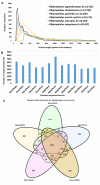De novo assembled salivary gland transcriptome and expression pattern analyses for Rhipicephalus evertsi evertsi Neuman, 1897 male and female ticks
- PMID: 33452281
- PMCID: PMC7810686
- DOI: 10.1038/s41598-020-80454-3
De novo assembled salivary gland transcriptome and expression pattern analyses for Rhipicephalus evertsi evertsi Neuman, 1897 male and female ticks
Abstract
Ticks secrete proteins in their saliva that change over the course of feeding to modulate the host inflammation, immune responses, haemostasis or may cause paralysis. RNA next generation sequencing technologies can reveal the complex dynamics of tick salivary glands as generated from various tick life stages and/or males and females. The current study represents 15,115 Illumina sequenced contigs of the salivary gland transcriptome from male and female Rhipicephalus evertsi evertsi ticks of early, mid and late feeding stages from 1320 separate assemblies using three short read assemblers. The housekeeping functional class contributed to the majority of the composition of the transcriptome (80%) but with lower expression (51%), while the secretory protein functional class represented only 14% of the transcriptome but 46% of the total coverage. Six percent had an unknown status contributing 3% of the overall expression in the salivary glands. Platelet aggregation inhibitors, blood clotting inhibitors and immune-modulators orthologous to the ancestral tick lineages were confirmed in the transcriptome and their differential expression during feeding in both genders observed. This transcriptome contributes data of importance to salivary gland biology and blood feeding physiology of non-model organisms.
Conflict of interest statement
The authors declare no competing interests.
Figures








Similar articles
-
Sialotranscriptomics of Rhipicephalus zambeziensis reveals intricate expression profiles of secretory proteins and suggests tight temporal transcriptional regulation during blood-feeding.Parasit Vectors. 2017 Aug 10;10(1):384. doi: 10.1186/s13071-017-2312-4. Parasit Vectors. 2017. PMID: 28797301 Free PMC article.
-
Gene Expression in the Salivary Gland of Rhipicephalus (Boophilus) microplus Fed on Tick-Susceptible and Tick-Resistant Hosts.Front Cell Infect Microbiol. 2020 Jan 21;9:477. doi: 10.3389/fcimb.2019.00477. eCollection 2019. Front Cell Infect Microbiol. 2020. PMID: 32039052 Free PMC article.
-
De novo assembly and annotation of the salivary gland transcriptome of Rhipicephalus appendiculatus male and female ticks during blood feeding.Ticks Tick Borne Dis. 2016 Jun;7(4):536-48. doi: 10.1016/j.ttbdis.2016.01.014. Epub 2016 Jan 22. Ticks Tick Borne Dis. 2016. PMID: 26830274
-
Small protease inhibitors in tick saliva and salivary glands and their role in tick-host-pathogen interactions.Biochim Biophys Acta Proteins Proteom. 2020 Feb;1868(2):140336. doi: 10.1016/j.bbapap.2019.140336. Epub 2019 Dec 7. Biochim Biophys Acta Proteins Proteom. 2020. PMID: 31816416 Review.
-
Tick salivary gland transcriptomics and proteomics.Parasite Immunol. 2021 May;43(5):e12807. doi: 10.1111/pim.12807. Epub 2020 Nov 16. Parasite Immunol. 2021. PMID: 33135186 Review.
Cited by
-
First transcriptome analysis of the winter tick (Dermacentor albipictus) reveals sex-specific expression patterns and potential targets for genetic control.G3 (Bethesda). 2025 Aug 6;15(8):jkaf116. doi: 10.1093/g3journal/jkaf116. G3 (Bethesda). 2025. PMID: 40408551 Free PMC article.
-
Alterations in arthropod and neuronal exosomes reduce virus transmission and replication in recipient cells.Extracell Vesicles Circ Nucl Acids. 2022;3(3):247-279. doi: 10.20517/evcna.2022.30. Epub 2022 Aug 31. Extracell Vesicles Circ Nucl Acids. 2022. PMID: 36939419 Free PMC article.
-
Transcriptomic Analysis of Salivary Glands of Ornithodoros brasiliensis Aragão, 1923, the Agent of a Neotropical Tick-Toxicosis Syndrome in Humans.Front Physiol. 2021 Aug 6;12:725635. doi: 10.3389/fphys.2021.725635. eCollection 2021. Front Physiol. 2021. PMID: 34421661 Free PMC article.
-
Arboviruses: How Saliva Impacts the Journey from Vector to Host.Int J Mol Sci. 2021 Aug 25;22(17):9173. doi: 10.3390/ijms22179173. Int J Mol Sci. 2021. PMID: 34502092 Free PMC article. Review.
References
Publication types
MeSH terms
Substances
LinkOut - more resources
Full Text Sources
Other Literature Sources

